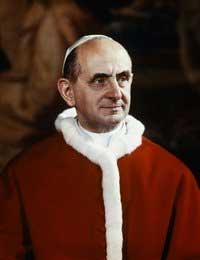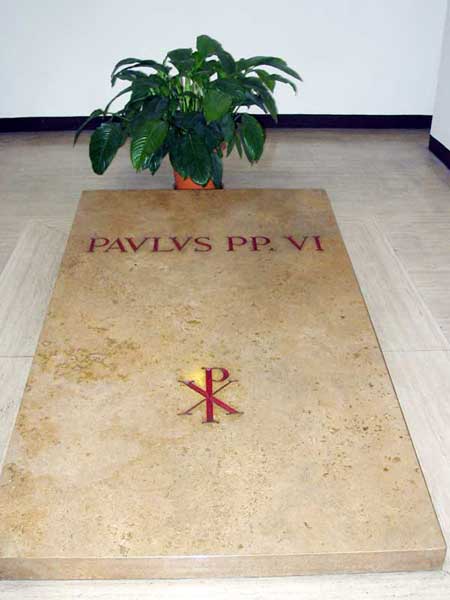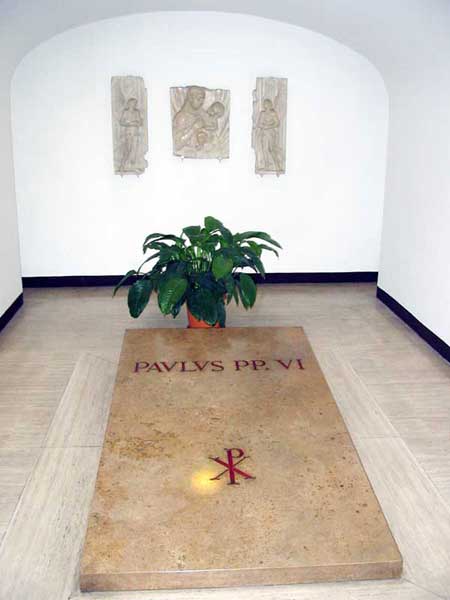


Pope Paul VI (Latin: Paulus PP. VI), born Giovanni Battista
Enrico Antonio Maria Montini (September 26, 1897 – August 6, 1978), reigned
as Pope and as sovereign of Vatican City from 1963 to 1978. He presided over
the Catholic Church during most of the Second Vatican Council and played a
central role in implementing its decisions.
Early career
Giovanni Montini was born in Concesio in Brescia province, Italy, of a
family of local nobility. He entered the seminary to train to become a
Catholic priest in 1916 and was ordained a priest in 1920. He studied at the
Gregorian University, the University of Rome and the Accademia dei Nobili
Ecclesiastici. His organisational skills led him to a career in the Curia,
the papal civil service. In 1937 he was named Substitute for Ordinary
Affairs under Cardinal Pacelli, the Secretary of State under Pope Pius XI.
When Pacelli was elected Pope Pius XII, Montini was confirmed in the
position under the new Secretary of State. When in 1944 the Secretary of
State died, the role was assumed directly by the pope, with Montini working
directly under him.
Some of his work during this period remains shrouded in mystery, with claims
and counter-claims, most notably concerning his involvement in the
diplomatic activities of the Vatican during the conflict. For example, the
Vatican's repeated contacts with Count Galeazzo Ciano, fascist Minister of
Foreign affairs and son-in-law of Mussolini, remains an issue of some
criticism. Montini, who worked as a diplomat, has been accused of having
obtained from the Fascists, at the beginning of the war, some promises of
uncleared advantages for the Vatican, in exchange of its eventual support.
However, many other historians dispute this analysis.
The unique complexity of the war-time period saw Montini procure large sums
of money to aid European Jews, while he is also alleged to have been
involved in enabling some leading Nazi officers to escape the collapse of
the Third Reich. Formally a simple administrative employee of the Vatican
government, but effectively the closest supporter of Pius XII, he has often
been recognised as one of the most important political figures of the
period. No official confirmation exists, but evidence indicates that he
(along with Alcide De Gasperi) attempted to set up a channel of
communication between Crown Princess Maria José (daughter-in-law of the King
of Italy and wife of the Prince of Piedmont, Umberto) and the United States,
in order to find a separate peace for Italy with the United States; the
Princess however was not able to meet Myron Taylor, President Franklin D.
Roosevelt's special representative to the Vatican, and no one knows if
Montini was unable to organise this meeting or unwilling to do so.
Archbishop of Milan
Montini was appointed in 1953 to the senior Italian church post of
Archbishop of Milan. Traditionally such appointment would be followed by
being made a cardinal at the next consistory (when vacancies in the College
of Cardinals are filled). To the surprise of many, Montini never received
the red hat (as the appointment to the cardinalate is often called) before
Pope Pius's death in 1958; what was not known was that at the Secret
Consistory in 1952 Pope Pius revealed that Montini had declined the
cardinalate. Though many viewed him as the person who would have succeeded
Pope Pius, since Montini was not a member of the College of Cardinals,[1]
Cardinal Angelo Roncalli was elected pope and assumed the name Pope John
XXIII. Roncalli almost immediately raised Montini to the cardinalate.
Pope
Montini was generally seen as Pope John's heir apparent. Montini was an
enthusiastic supporter of Pope John's decision to establish the Second
Vatican Council. When John died of cancer in 1963, Montini finally was
elected to the papacy, where he took the name Paul VI. He brought the Second
Vatican Council to completion in 1965 and directed the implementation of its
directives until his death in 1978. He was also the last pope to be crowned;
his successor Pope John Paul I abolished the ceremony during his reign,
though it could be reinstated. Paul VI donated his own Papal Tiara, a gift
from his former Archdiocese of Milan, to the Basilica of the National Shrine
of the Immaculate Conception in Washington, D.C. as a gift to American
Catholics. In 1965 he established the Synod of Bishops but controversially
withdrew two issues from its authority, priestly celibacy and the issue of
contraception and made both the subject of controversial encyclicals.
Humanæ Vitæ
Pope Paul's most controversial decision occurred on July 24, 1968, when
in his encyclical Humanæ Vitæ, "Of Human Life", he rejected the
recommendations of a commission established by John XXIII and reaffirmed the
Catholic Church's condemnation of artificial birth control. His decision was
unexpected, as many in the Catholic world expected the Church to accept with
some reservations the technological advances that had produced the
contraceptive pill. In subsequent decades, many Catholics opted to use birth
control in spite of church teaching. To its supporters, Humanæ Vitæ is seen
as a valued and welcome reaffirming of the sanctity of human sexuality and
the procreative act, unencumbered by a modern drift away from absolute to
relative concepts of morality.
A commission composed of bishops, theologians, and laity had been
established for the purpose of reviewing the teaching on birth control. It
was the commission's majority recommendation that the Church relax its
stance on birth control. Upon the receiving the commission's report, Pope
Paul made the highly controversial decision to disband the commission, and
not only ignored their recommendations, but did exactly the opposite and
with his Humanæ Vitæ encyclical reinforced the ban on birth control.
The encyclical gained further significance as the Catholic faithful began to
feel disenfranchised from the Church. Whereas in the past, the Vatican's
historical conciliarism provided checks and balances on the Pope's
authority, with Pope Paul VI's rejection and disbandment of the commission
these checks and balances of the past were swept away. The Pope's authority
in Church matters had became elevated to monarchical power.
As public opinion seemed to turn against the Pope, it was the last
encyclical of his papacy.
To its many opponents, Humanæ Vitæ is seen as a calamity akin to Pope Pius
IX's Syllabus of Errors, with the Church turning its back on technological
advances that could help humanity deal with the problems of serial births
and climbing birth rates, particularly in the Third World. External
observers noted that many lay Catholics reacted by moving towards the more
typically Protestant attitude that after listening to the Church's teaching,
they could judge for themselves what was sinful and what was not.
While Paul's successor, Pope John Paul I, in a meeting with United Nations
population experts during his short reign, did give some indication that
Humanæ Vitæ might be changed somewhat, Pope John Paul II unambiguously
supported the encyclical.
The Pilgrim Pope
Pope Paul VI became the first pope to visit five continents, and was the
most travelled pope in history to that time, earning the nickname the
Pilgrim Pope. In 1970 he was the target of an assassination attempt at
Manila International Airport in the Philippines. The assailant, a Bolivian
Surrealist painter named Benjamín Mendoza y Amor Flores, lunged toward Pope
Paul with a kris, but was subdued. Although the Vatican denied it,
subsequent evidence suggests Pope Paul did indeed receive a stab wound in
the incident.
Pope Paul became the second pope to meet an Anglican Archbishop of
Canterbury, Michael Ramsey, after the visit of Archbishop Geoffrey Fisher to
Pope John XXIII on December 2nd 1960. He was also the first pope for
centuries to meet the heads of various Eastern Orthodox faiths. Notably, in
1964 he met Patriarch Athenagoras of Constantinople and they rescinded the
1054 excommunications of the Great Schism and produced the Catholic-Orthodox
Joint declaration of 1965.
An Indecisive Pope?
According to some critics, Pope Paul VI was habitually indecisive.
One example of Paul's alleged indecisiveness revolved around his inability
to decide how to deal with the scandal-ridden American Cardinal Cody, who
was surrounded by allegations of financial and sexual impropriety. Cody even
invited his female 'friend' to pose in a picture with him and Pope Paul
taken when Cody was being awarded the red hat. Paul changed his mind over
whether to remove Cody, on one occasion contacting a Vatican official at
Rome Airport, whom he had sent to inform Cody of his dismissal, and telling
him to return as he had changed his mind. Cody remained in office until his
death.
Some critics point to Paul's response to Archbishop Lefebvre, who challenged
papal authority by refusing to accept the New Mass and liturgical reforms
produced by Vatican II. The pope summoned Lefebvre to meetings in which he
argued with Lefebvre and showed his great frustration, but he did not
excommunicate Lefebvre, as many had expected. Lefebvre was eventually
excommunicated automatically (latae sententiae) for his illicit ordinations
in 1988 during the reign of Pope John Paul II.
The pope's response to the critics of Humanae Vitae is also cited as an
example of indecisiveness. When Cardinal O'Boyle, the Archbishop of
Washington, D.C., disciplined several priests for publicly dissenting from
this teaching, the pope gave him encouragement. But when other bishops did
nothing to quell dissent, the pope raised no objection. And when bishops in
Canada, France, Sweden, and the Netherlands were lukewarm in their support
or even publicly expressed reservations about this teaching, the pope did
not discipline them in any way.
Some of Pope Paul's statements in the 1970s seemed critical of the direction
taken by the Church after Vatican II, expressing his dislike of some of the
"pedestrian" language used in some translations of the New Mass. But he did
not generally indicate such unhappiness in his public statements. He did
oppose Liberation theology after the 1962-65 Vatican Council, frowning on
the CELAM (Latin American Episcopal Conference) support to it.
According to some sources, as Paul became older he spoke of abdicating the
papal throne and going into retirement. Some critics see this as another
example of indecision, as he remained in the papacy until his death.
It is rumored that Pope John XXIII referred to then-Cardinal Montini as "Our
Hamlet" (Amleto), in reference to his indecisiveness. The private
secretaries of both popes have denied that John ever made such a statement.
Pope Paul himself reflected that description of himself in a private note
written in 1978. He asked:
What is my state of mind? Am I Hamlet? Or Don Quixote? On the left? On the
right? I do not think I have been properly understood.[2]
Controversial sermons
On June 29, 1972 Pope Paul VI in a homily delivered a strikingly
downbeat analysis of the state of the Roman Catholic Church post Vatican II.
He told a congregation:
We believed that after the Council would come a day of sunshine in the
history of the Church. But instead there has come a day of clouds and
storms, and of darkness ... And how did this come about? We will confide to
you the thought that may be, we ourselves admit in free discussion, that may
be unfounded, and that is that there has been a power, an adversary power.
Let us call him by his name: the devil.
His fears of satanic infiltration of the Church were even more pronounced in
a later sentence which is widely quoted by conservative Catholics. He said:
It is as if from some mysterious crack, no, it is not mysterious, from some
crack the smoke of Satan has entered the temple of God.
What he was alluding to was never explained. Some members of the
traditionalist movement have used that quote as a defense of their positions
on the direction the Church has taken following the council.
A few months before his death, Paul celebrated the solemn funeral of the
leader of Democrazia Cristiana, Aldo Moro (Moro was murdered by the Red
Brigades), who had sent him a famous letter from captivity. Moro and Montini
had been in the FUCI together, a Catholic association for university
students, many years before, and in time had become perhaps the two most
important Catholic figures in Italy.
Denial of homosexual rumours
Pope Paul VI caused considerable surprise in 1968 when, to the
consternation of his aides, he apparently denied rumours that he was
homosexual. Though rumours had circulated periodically in anti-papal and
anti-Catholic publications as to Paul's sexual orientation, with suggestions
of a past relationship while he was an archbishop with a priest who had
served as his secretary, when what Paul called the "scandalous rumours"
began to feature in some elements of the Italian media, he made the
controversial choice of issuing a public denial. It was the first time in
the modern era that a pope had commented in any way about his sexual
identity. [3] Controversy remains among historians as to whether the term
"scandalous rumours" actually referred to the Pope's sexuality, or various
other rumours concerning his papacy.
Footnotes
1 could still have become pope. In fact, at the 1958 election, Montini
did receive a couple of votes. But the cardinals in modern times invariably
elect a fellow cardinal to the post.
2 Cathal B Daly, Steps on my Pilgrim Journey (Veritas, 1998) p.
|


